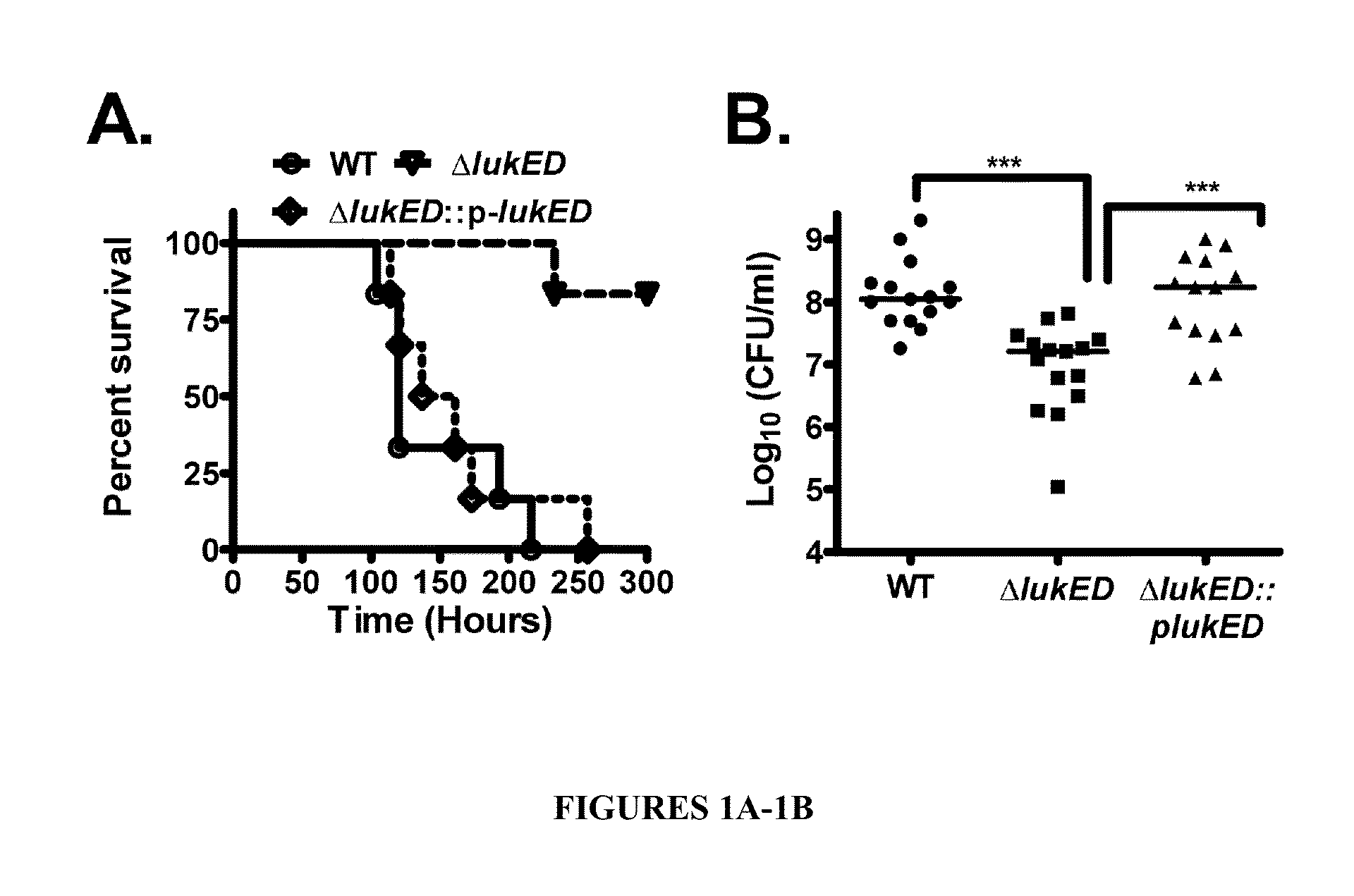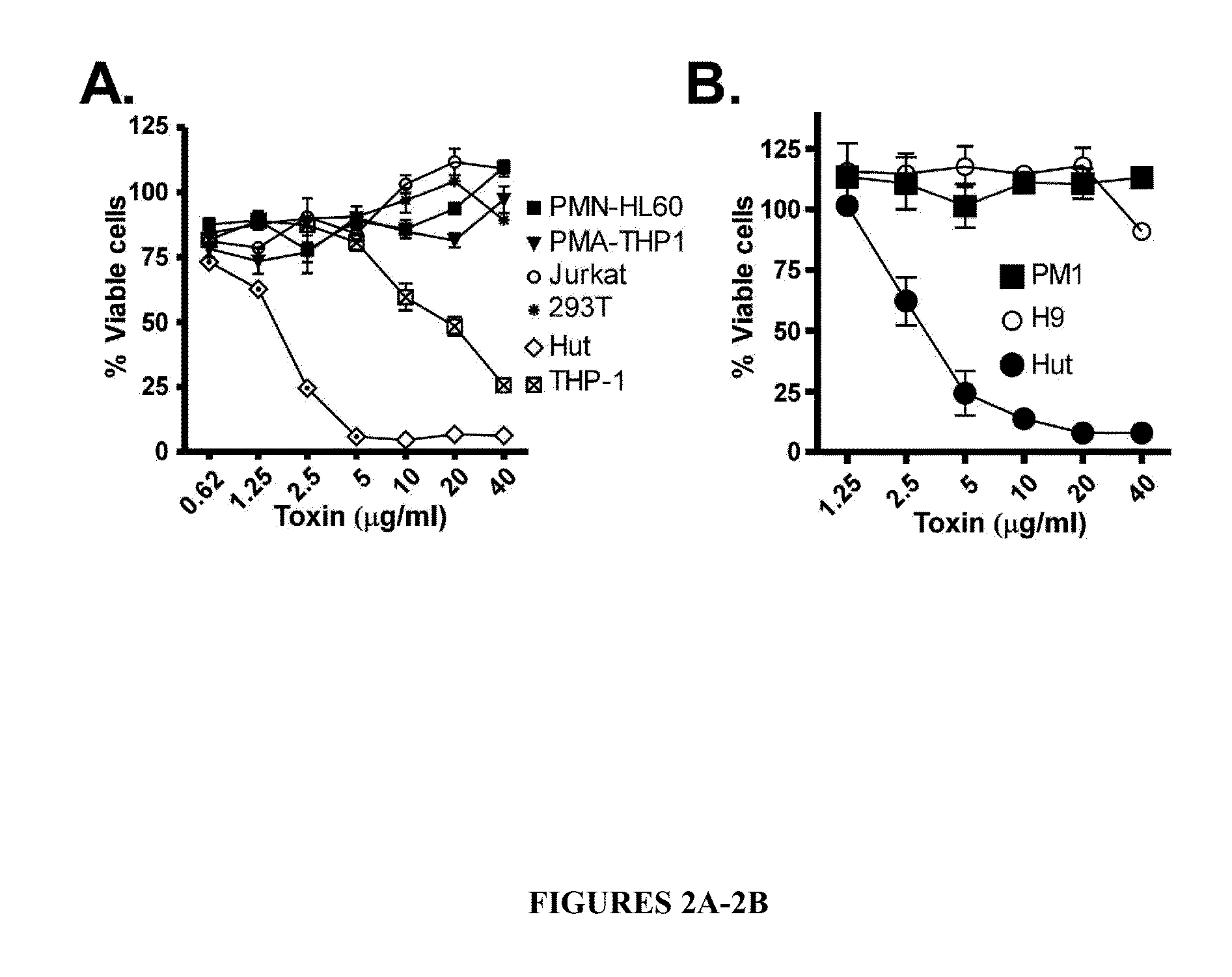Leukotoxin e/d as a new Anti-inflammatory agent and microbicide
a technology of leukotoxin and microbicide, which is applied in the direction of drug composition, immunological disorders, metabolism disorders, etc., can solve the problems of bacterial dissemination and disease, and the design of effective therapy for mrsa infection has been particularly challenging, so as to prevent the transmission of hiv, and improve the effect of anti-inflammatory
- Summary
- Abstract
- Description
- Claims
- Application Information
AI Technical Summary
Benefits of technology
Problems solved by technology
Method used
Image
Examples
example 1
LukE / D Significantly Contributes to S. aureus Pathogenesis
[0085]To test whether LukE / D plays a major role in the pathogenesis of S. aureus septicemic infection, a ΔlukE / D mutant in the MSSA strain Newman was constructed and the impact of the lukE / D deletion on virulence examined. Survival over time dramatically increased for mice infected with 107 CFU of the ΔlukE / D mutant compared to that of mice infected with wild type (WT) S. auerus. All mice infected with WT S. aureus succumbed to infection by 250 hours. In contrast, nearly 100% of mice infected with ΔlukE / D mutant survived until at least 300 hours post infection, a phenotype fully complemented by introducing lukE / D into the ΔlukE / D mutant strain (ΔlukE / D::plukE / D; FIG. 1A). In addition, bacterial burden to the kidney was reduced by 10-fold compared to the WT or complemented strain (FIG. 1B). These results show that LukE / D is a critical virulence factor for S. aureus systemic infection. Thus LukE / D is an attractive novel target ...
example 2
LukE / D Selectively Kills Human Immune Cell Lines
[0086]As described supra, LukE / D contributes to the pathogenesis of S. aureus mediated sepsis and systemic infection (FIGS. 1A-1B), indicating that inhibiting LukE / D could prove to be a novel mean by which to treat S. aureus infections.
[0087]One mechanism by which LukE / D could be blocked is by inhibiting the interaction of the toxin with its receptor. As an initial strategy to understand how LukE / D interact with host cells, a collection of human immune cell lines were incubated (“intoxicated”) with different concentrations of either individual subunits (i.e., LukE or LukD) or an equimolar mixture of LukE+LukD (LukE / D). These experiments revealed that LukE / D exhibits cytotoxicity toward THP1 cells (human monocytes) and Hut cells (T lymphocyte-like cells) (FIG. 2A). Interestingly, LukE / D was cytotoxic towards Hut cells but not towards Jurkat cells, both commonly used T lymphocyte-like cells. This surprising result prompted investigation ...
example 3
LukE / D Targets and Kills Cells in a CCR5-Dependent Manner
[0088]To directly determine the contribution of CCR5 for the ability of LukE / D to target and kill host cells, CCR5 was introduced into Jurkat cells by viral transduction of the CCR5 cDNA resulting in CCR5+ Jurkat. Jurkat and CCR5+ Jurkat cells were subsequently intoxicated with different concentrations of either individual subunits (i.e., LukE or LukD) or equimolar mixtures of LukE+LukD (LukE / D). This experiment revealed that production of CCR5 was sufficient to render Jurkat cells susceptible to LukE / D mediated toxicity (FIG. 3, top panel). Importantly, similar results were observed when the human osteosarcoma cell line “GHOST” cells engineered to produce CCR5 on their surface were examined (FIG. 3 bottom panel). Altogether, these data indicate that CCR5 renders mammalian cells susceptible to LukE / D mediated cytotoxicity.
PUM
| Property | Measurement | Unit |
|---|---|---|
| Antimicrobial properties | aaaaa | aaaaa |
Abstract
Description
Claims
Application Information
 Login to View More
Login to View More - R&D
- Intellectual Property
- Life Sciences
- Materials
- Tech Scout
- Unparalleled Data Quality
- Higher Quality Content
- 60% Fewer Hallucinations
Browse by: Latest US Patents, China's latest patents, Technical Efficacy Thesaurus, Application Domain, Technology Topic, Popular Technical Reports.
© 2025 PatSnap. All rights reserved.Legal|Privacy policy|Modern Slavery Act Transparency Statement|Sitemap|About US| Contact US: help@patsnap.com



